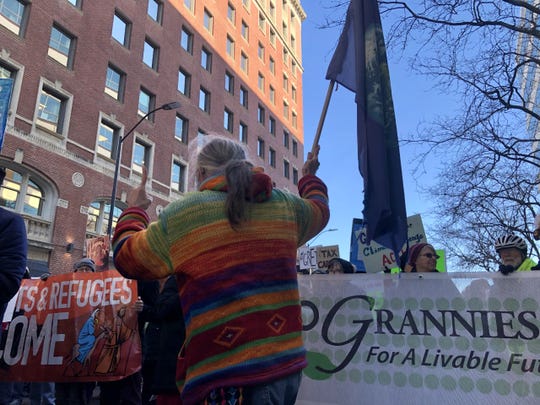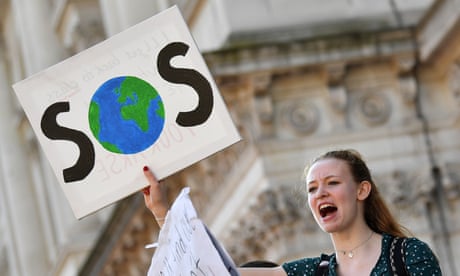Here are 10 things you need to know about socialism
By YES! Magazine - Commentary

What do we mean when we talk about “socialism”? Here are ten things about its theory, practice, and potential that you need to know.
Over the last 200 years, socialism has spread across the world. In every country, it carries the lessons and scars of its particular history there. Conversely, each country’s socialism is shaped by the global history, rich tradition, and diverse interpretations of a movement that has been the world’s major critical response to capitalism as a system.
We need to understand socialism because it has shaped our history and will shape our future. It is an immense resource: the accumulated thoughts, experiences, and experiments accomplished by those yearning to do better than capitalism.
In my latest book, Understanding Socialism (Democracy at Work, 2019), I gather and present the basic theories and practices of socialism. I examine its successes, explore its challenges, and confront its failures. The point is to offer a path to a new socialism based on workplace democracy. Here are 10 things from this book that you should know.
1. Socialism is a yearning for something better than capitalism
Socialism represents the awareness of employees that their sufferings and limitations come less from their employers than from the capitalist system. That system prescribes incentives and options for both sides, and rewards and punishments for their behavioral “choices.” It generates their endless struggles and the employees’ realization that system change is the way out.
In Capital, Volume 1, Karl Marx defined a fundamental injustice—exploitation—located in capitalism’s core relationship between employer and employee. Exploitation, in Marx’s terms, describes the situation in which employees produce more value for employers than the value of wages paid to them. Capitalist exploitation shapes everything in capitalist societies. Yearning for a better society, socialists increasingly demand the end of exploitation and an alternative in which employees function as their own employer. Socialists want to be able to explore and develop their full potentials as individuals and members of society while contributing to its welfare and growth.

 Karl Marx, date unknown. Photo from Bettmann/Getty Images.
Karl Marx, date unknown. Photo from Bettmann/Getty Images.
Socialism is an economic system very different from capitalism, feudalism, and slavery. Each of the latter divided society into a dominant minority class (masters, lords, and employers) and a dominated majority (slaves, serfs, employees). When the majority recognized slavery and feudal systems as injustices, they eventually fell.
The majorities of the past fought hard to build a better system. Capitalism replaced slaves and serfs with employees, masters and lords with employers. It is no historical surprise that employees would end up yearning and fighting for something better. That something better is socialism, a system that doesn’t divide people, but rather makes work a democratic process where all employees have an equal say and together are their own employer.
2. Socialism is not a single, unified theory
People spread socialism across the world, interpreting and implementing it in many different ways based on context. Socialists found capitalism to be a system that produced ever-deepening inequalities, recurring cycles of unemployment and depression, and the undermining of human efforts to build democratic politics and inclusive cultures. Socialists developed and debated solutions that varied from government regulations of capitalist economies to government itself owning and operating enterprises, to a transformation of enterprises (both private and government) from top-down hierarchies to democratic cooperatives.
Sometimes those debates produced splits among socialists. After the Russian Revolution of 1917, socialists supporting the post-revolutionary Soviet Union underscored their commitment to socialism that entailed the government owning and operating industries by adopting the new name “communist.” Those skeptical of Soviet-style socialism tended increasingly to favor state regulation of private capitalists. They kept the name “socialist” and often called themselves social democrats or democratic socialists. For the last century, the two groups debated the merits and flaws of the two alternative notions of socialism as embodied in examples of each (e.g. Soviet versus Scandinavian socialisms).
Early in the 21st century, an old strain of socialism resurfaced and surged. It focuses on transforming the inside of enterprises: from top-down hierarchies, where a capitalist or a state board of directors makes all the key enterprise decisions, to a worker cooperative, where all employees have equal, democratic rights to make those decisions, thereby becoming—collectively—their own employer.
3 .The Soviet Union and China achieved state capitalism, not socialism
As leader of the Soviet Union, Lenin once said that socialism was a goal, not yet an achieved reality. The Soviet had, instead, achieved “state capitalism.” A socialist party had state power, and the state had become the industrial capitalist displacing the former private capitalists. The Soviet revolution had changed who the employer was; it had not ended the employer/employee relationship. Thus, it was—to a certain extent—capitalist.
Lenin’s successor, Stalin, declared that the Soviet Union had achieved socialism. In effect, he offered Soviet state capitalism as if it were the model for socialism worldwide. Socialism’s enemies have used this identification ever since to equate socialism with political dictatorship. Of course, this required obscuring or denying that (1) dictatorships have often existed in capitalist societies and (2) socialisms have often existed without dictatorships.
After initially copying the Soviet model, China changed its development strategy to embrace instead a state-supervised mix of state and private capitalism focused on exports. China’s powerful government would organize a basic deal with global capitalists, providing cheap labor, government support, and a growing domestic market. In exchange, foreign capitalists would partner with Chinese state or private capitalists, share technology, and integrate Chinese output into global wholesale and retail trade systems. China’s brand of socialism—a hybrid state capitalism that included both communist and social-democratic streams—proved it could grow faster over more years than any capitalist economy had ever done.
4. The U.S., Soviet Union, and China have more in common than you think
As capitalism emerged from feudalism in Europe in the 19th century, it advocated liberty, equality, fraternity, and democracy. When those promises failed to materialize, many became anti-capitalist and found their way to socialism.
Experiments in constructing post-capitalist, socialist systems in the 20th century (especially in the Soviet Union and China) eventually incurred similar criticisms. Those systems, critics held, had more in common with capitalism than partisans of either system understood.
Self-critical socialists produced a different narrative based on the failures common to both systems. The U.S. and Soviet Union, such socialists argue, represented private and state capitalisms. Their Cold War enmity was misconstrued on both sides as part of the century’s great struggle between capitalism and socialism. Thus, what collapsed in 1989 was Soviet State capitalism, not socialism. Moreover, what soared after 1989 was another kind of state capitalism in China.
5. Thank American socialists, communists, and unionists for the 1930s New Deal
FDR’s government raised the revenue necessary for Washington to fund massive, expensive increases in public services during the Depression of the 1930s. These included the Social Security system, the first federal unemployment compensation system, the first federal minimum wage, and a mass federal jobs program. FDR’s revenues came from taxing corporations and the rich more than ever before.
 President Franklin D. Roosevelt, center, and his New Deal administration team on September 12, 1935. Photo by Keystone-France/Gamma-Keystone/Getty Images.
President Franklin D. Roosevelt, center, and his New Deal administration team on September 12, 1935. Photo by Keystone-France/Gamma-Keystone/Getty Images.
In response to this radical program, FDR was reelected three times. His radical programs were conceived and pushed politically from below by a coalition of communists, socialists, and labor unionists. He had not been a radical Democrat before his election.
Socialists obtained a new degree of social acceptance, stature, and support from FDR’s government. The wartime alliance of the U.S. with the Soviet Union strengthened that social acceptance and socialist influences.
6. If 5 was news to you, that’s due to the massive U.S.-led global purge of socialists and communists after WWII
After its 1929 economic crash, capitalism was badly discredited. The unprecedented political power of a surging U.S. left enabled government intervention to redistribute wealth from corporations and the rich to average citizens. Private capitalists and the Republican Party responded with a commitment to undo the New Deal. The end of World War II and FDR’s death in 1945 provided the opportunity to destroy the New Deal coalition.
The strategy hinged on demonizing the coalition’s component groups, above all the communists and socialists. Anti-communism quickly became the strategic battering ram. Overnight, the Soviet Union went from wartime ally to an enemy whose agents aimed “to control the world.” That threat had to be contained, repelled, and eliminated.
U.S. domestic policy focused on anti-communism, reaching hysterical dimensions and the public campaigns of U.S. Sen. Joseph McCarthy. Communist Party leaders were arrested, imprisoned, and deported in a wave of anti-communism that quickly spread to socialist parties and to socialism in general. Hollywood actors, directors, screenwriters, musicians, and more were blacklisted and barred from working in the industry. McCarthy’s witch hunt ruined thousands of careers while ensuring that mass media, politicians, and academics would be unsympathetic, at least publicly, to socialism. U.S. Sen. Joseph McCarthy led a campaign to put prominent government officials and others on trial for alleged “subversive activities” and Communist Party membership during the height of the Cold War.
U.S. Sen. Joseph McCarthy led a campaign to put prominent government officials and others on trial for alleged “subversive activities” and Communist Party membership during the height of the Cold War.
Photo by Corbis/Getty Images.
In other countries revolts from peasants and/or workers against oligarchs in business and/or politics often led the latter to seek U.S. assistance by labeling their challengers as “socialists” or “communists.” Examples include U.S. actions in Guatemala and Iran (1954), Cuba (1959-1961), Vietnam (1954-1975), South Africa (1945-1994), and Venezuela (since 1999). Sometimes the global anti-communism project took the form of regime change. In 1965-6 the mass killings of Indonesian communists cost the lives of between 500,000 to 3 million people.
Once the U.S.—as the world’s largest economy, most dominant political power, and most powerful military—committed itself to total anti-communism, its allies and most of the rest of the world followed suit.
7. Since socialism was capitalism’s critical shadow, it spread to those subjected by and opposed to capitalist colonialism
In the first half of the 20th century, socialism spread through the rise of local movements against European colonialism in Asia and Africa, and the United States’ informal colonialism in Latin America. Colonized people seeking independence were inspired by and saw the possibility of alliances with workers fighting exploitation in the colonizing countries. These latter workers glimpsed similar possibilities from their side.
This helped create a global socialist tradition. The multiple interpretations of socialism that had evolved in capitalism’s centers thus spawned yet more and further-differentiated interpretations. Diverse streams within the anti-colonial and anti-imperialist tradition interacted with and enriched socialism.

8. Fascism is a capitalist response to socialismA fascist economic system is capitalist, but with a mixture of very heavy government influence. In fascism, the government reinforces, supports, and sustains private capitalist workplaces. It rigidly enforces the employer/employee dichotomy central to capitalist enterprises. Private capitalists support fascism when they fear losing their position as capitalist employers, especially during social upheavals.
Under fascism, there is a kind of mutually supportive merging of government and private workplaces. Fascist governments tend to “deregulate,” gutting worker protections won earlier by unions or socialist governments. They help private capitalists by destroying trade unions or replacing them with their own organizations which support, rather than challenge, private capitalists.
Frequently, fascism embraces nationalism to rally people to fascist economic objectives, often by using enhanced military expenditures and hostility toward immigrants or foreigners. Fascist governments influence foreign trade to help domestic capitalists sell goods abroad and block imports to help them sell their goods inside national boundaries. Blackshirts, supporters of Benito Mussolini who founded the National Fascist Party, are about to set fire to portraits of Karl Marx and Vladimir Lenin in Italy in May 1921. Photo by Mondadori/Getty Images.
Blackshirts, supporters of Benito Mussolini who founded the National Fascist Party, are about to set fire to portraits of Karl Marx and Vladimir Lenin in Italy in May 1921. Photo by Mondadori/Getty Images.
Usually, fascists repress socialism. In Europe’s major fascist systems—Spain under Franco, Germany under Hitler, and Italy under Mussolini—socialists and communists were arrested, imprisoned, and often tortured and killed.
A similarity between fascism and socialism seems to arise because both seek to strengthen government and its interventions in society. However, they do so in different ways and toward very different ends. Fascism seeks to use government to secure capitalism and national unity, defined often in terms of ethnic or religious purity. Socialism seeks to use government to end capitalism and substitute an alternative socialist economic system, defined traditionally in terms of state-owned and -operated workplaces, state economic planning, employment of dispossessed capitalists, workers’ political control, and internationalism.
9. Socialism has been, and still is, evolving
During the second half of the 20th century, socialism’s diversity of interpretations and proposals for change shrank to two alternative notions: 1.) moving from private to state-owned-and -operated workplaces and from market to centrally planned distributions of resources and products like the Soviet Union, or 2.) “welfare-state” governments regulating markets still comprised mostly of private capitalist firms, as in Scandinavia, and providing tax-funded socialized health care, higher education, and so on. As socialism returns to public discussion in the wake of capitalism’s crash in 2008, the first kind of socialism to gain mass attention has been that defined in terms of government-led social programs and wealth redistributions benefitting middle and lower income social groups.
The evolution and diversity of socialism were obscured. Socialists themselves struggled with the mixed results of the experiments in constructing socialist societies (in the Soviet Union, China, Cuba, Vietnam, etc.). To be sure, these socialist experiments achieved extraordinary economic growth. In the Global South, socialism arose virtually everywhere as the alternative development model to a capitalism weighed down by its colonialist history and its contemporary inequality, instability, relatively slower economic growth, and injustice.
Socialists also struggled with the emergence of central governments that used excessively concentrated economic power to achieve political dominance in undemocratic ways. They were affected by criticisms from other, emerging left-wing social movements, such as anti-racism, feminism, and environmentalism, and began to rethink how a socialist position should integrate the demands of such movements and make alliances.
10. Worker co-ops are a key to socialism’s future
The focus of the capitalism-versus-socialism debate is now challenged by the changes within socialism. Who the employers are (private citizens or state officials) now matters less than what kind of relationship exists between employers and employees in the workplace. The role of the state is no longer the central issue in dispute.
A growing number of socialists stress that previous socialist experiments inadequately recognized and institutionalized democracy. These self-critical socialists focus on worker cooperatives as a means to institutionalize economic democracy within workplaces as the basis for political democracy. They reject master/slave, lord/serf, and employer/employee relationships because these all preclude real democracy and equality. Homesteaders, relocated by the U.S. Resettlement Administration, a federal agency under the New Deal, working at a cooperative garment factory in Hightstown, New Jersey, in 1936. The U.S. Resettlement Administration relocated struggling families to provide work relief. Photo by Universal History Archive/Universal Images Group/Getty Images.
Homesteaders, relocated by the U.S. Resettlement Administration, a federal agency under the New Deal, working at a cooperative garment factory in Hightstown, New Jersey, in 1936. The U.S. Resettlement Administration relocated struggling families to provide work relief. Photo by Universal History Archive/Universal Images Group/Getty Images.
For the most part, 19th and 20th century socialisms downplayed democratized workplaces. But an emerging, 21st century socialism advocates for a change in the internal structure and organization of workplaces. The microeconomic transformation from the employer/employee organization to worker co-ops can ground a bottom-up economic democracy.
The new socialism’s difference from capitalism becomes less a matter of state versus private workplaces, or state planning versus private markets, and more a matter of democratic versus autocratic workplace organization. A new economy based on worker co-ops will find its own democratic way of structuring relationships among co-ops and society as a whole.
Worker co-ops are key to a new socialism’s goals. They criticize socialisms inherited from the past and add a concrete vision of what a more just and humane society would look like. With the new focus on workplace democratization, socialists are in a good position to contest the 21st century’s struggle of economic systems.
Richard D. Wolff is Professor of Economics Emeritus, University of Massachusetts, Amherst, and a Visiting Professor in the Graduate Program in International Affairs of the New School University, NYC. He taught economics at Yale University, the City University of New York, and the University of Paris. Over the last 25 years, in collaboration with Stephen Resnick, he has developed a new approach to political economy that appears in several books co-authored by Resnick and Wolff and numerous articles by them separately and together. Professor Wolff’s weekly show, “Economic Update,” is syndicated on over 90 radio stations and goes to 55 million TV receivers via Free Speech TV and other networks.




























 Karl Marx, date unknown. Photo from Bettmann/Getty Images.
Karl Marx, date unknown. Photo from Bettmann/Getty Images.



